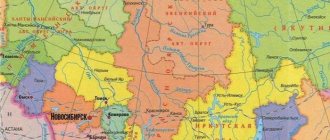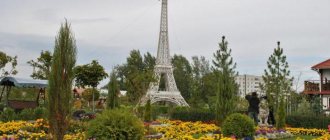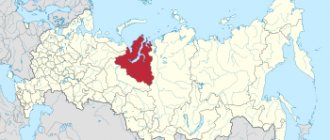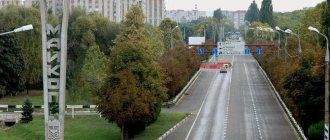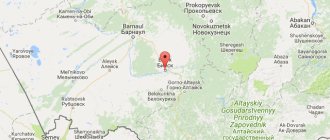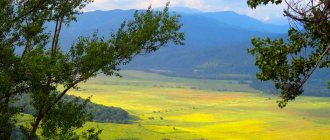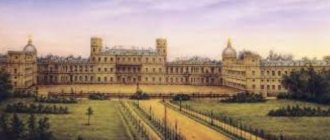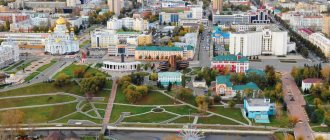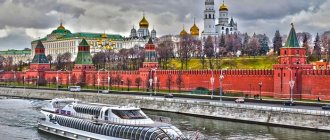Despite the fact that the Republic of Khakassia is an integral part of Russia, not all Russians are familiar with its history, geography and language. And some cannot even name its exact location. However, the region where Khakassia is located is of great interest from a scientific and cultural point of view, because the first human settlements appeared here thirty thousand years ago, and the first states were formed in the 1st century BC. e.
Economic-geographical location
The republic occupies a little more than 0.3% of the territory of Russia, but even with such a small territory, it is located in three climatic zones - steppe, forest-steppe and taiga. Together with the mountainous terrain, this makes the nature of Khakassia incredibly beautiful and diverse, and therefore popular among travelers. The region borders Altai, Tyva, Krasnoyarsk Territory and Kemerovo Region.
However, the population density in the republic is also not high, because the population of Khakassia barely exceeds half a million people, of which more than four hundred thousand live in cities.
see also
- Khakassia
- Cities of Russia
| [ + ] Cities by regions of Russia | |
| Cities of the North-West (NWFD) | St. Petersburg (and its cities) • Leningrad region (historical Staraya Ladoga) • Arkhangelsk region • Vologda region • Kaliningrad region • Karelia • Komi • Murmansk region • Nenets Autonomous Okrug • Pskov region |
| Cities of the Volga region (Volga Federal District) | Bashkortostan • Volgograd region • Kalmykia • Kirov region • Mari El • Mordovia • Nizhny Novgorod region • Orenburg region • Penza region • Perm region • Samara region • Saratov region • Tatarstan • Udmurtia • Ulyanovsk region • Chuvashia |
| Cities of Southern Russia (SFD) | Sevastopol (including Inkerman) • Republic of Crimea • Adygea • Astrakhan region • Krasnodar region • Rostov region |
| Cities of the North Caucasus (NCFD) | Dagestan • Ingushetia • Kabardino-Balkaria • Karachay-Cherkessia • North Ossetia - Alania • Stavropol Territory • Chechen Republic |
| Cities of the Urals (Ural Federal District) | Kurgan region • Sverdlovsk region • Tyumen region • Khanty-Mansi Autonomous Okrug - Yugra • Chelyabinsk region • Yamalo-Nenets Autonomous Okrug |
| Cities of Siberia (Siberian Federal District) | Altai Republic • Altai Territory • Irkutsk Region • Kemerovo Region • Krasnoyarsk Region • Novgorod Region • Novosibirsk Region • Omsk Region • Tomsk Region • Tyva • Khakassia |
| Cities of the Far East (FEFD) | Amur Region • Buryatia • Jewish Autonomous Region • Trans-Baikal Territory • Kamchatka Territory • Magadan Region • Primorsky Territory • Sakha (Yakutia) • Sakhalin Region • Khabarovsk Territory • Chukotka Autonomous Region |
| see also | Cities of the DPR, LPR, Transnistria, South Ossetia • Regions of Russia • Cities of Russia |
Cities of Khakassia
Let's talk about some settlements with a population exceeding three thousand people.
There are twenty-one such cities in Khakassia. The smallest of them is Top of Thea - a small town whose population barely exceeded three thousand. The settlement is located in a picturesque mountain taiga area.
The three largest cities include Sayanogorsk, Chernogorsk and the capital of the republic, Abakan.
Sayanogorsk, which received its name for its excellent view of the Western Saun ridges, is the third largest city in the republic, with a population of more than 48,000 inhabitants. It is worth saying that the city is located in the steppe zone, favorable for grazing livestock. The city does not have its own railway station, and the nearest one is forty-five kilometers away. The capital of the region, Abakan, is located eighty kilometers from Sayanogorsk.
The population of the second largest and most important city in Khakassia reaches almost 75,000 people, which is quite a lot for the region where Khakassia is located. Chernogorsk appeared due to the fact that coal mining began in this area in 1907; it was because of the black color of the surrounding hills that the city got its name. The city's population is likely due to its proximity to the republican center, which provides access to important social and economic infrastructure.
Government of the Republic of Khakassia
The administrative-territorial structure of the Republic of Khakassia is established by the Law of the Republic of Khakassia dated May 5, 2004 No. 20 “On the administrative-territorial structure of the Republic of Khakassia” (with subsequent amendments).
According to this law, the territory of the Republic of Khakassia is an integral part of the unified territory of the Russian Federation.
The legal basis of the administrative-territorial structure of the Republic of Khakassia is the Constitution of the Russian Federation, federal laws, the Constitution of the Republic of Khakassia, Law of the Republic of Khakassia dated May 5, 2004 No. 20 “On the administrative-territorial structure of the Republic of Khakassia” (with subsequent amendments), this Law and other regulatory legal acts of the Republic of Khakassia.
The Republic of Khakassia includes the following territories:
cities:
- Abakan;
- Abaza;
- Sayanogorsk;
- Sorsk;
- Chernogorsk.
areas:
- Altaisky is the administrative center of the village. Bely Yar;
- Askizsky is the administrative center of the village. Askiz;
- Beysky is the administrative center of the village. Bey;
- Bogradsky is the administrative center of the village. Bograd;
- Ordzhonikidzevsky is the administrative center of the village of Kopievo;
- Tashtypsky is the administrative center of the village. Tashtyp;
- Ust-Abakansky is the administrative center of the urban-type settlement Ust-Abakan;
- Shirinsky is the administrative center of the village. Shira.
In the Republic of Khakassia as of January 1, 2014 there are 100 municipalities
. Among them:
- urban districts – 5;
- municipal districts – 8;
- settlements – 87, of which rural settlements – 83, urban settlements – 4.
The capital of the Republic of Khakassia is the city of Abakan . The city is located at the confluence of the Abakan River with the Yenisei. Founded in 1675 (Abakan fort), from the 1780s. - With. Ust-Abakanskoye, from 1925 - the village of Khakassk, from 1931 - the city of Abakan.
Changes in the administrative-territorial structure of the Republic of Khakassia are made in accordance with the Constitution of the Republic of Khakassia, Law of the Republic of Khakassia dated May 5, 2004 20 “On the administrative-territorial structure of the Republic of Khakassia” and are reflected in the description of the borders.
In 2004, laws of the Republic of Khakassia were adopted on approving the boundaries of urban districts and municipal districts and giving them the appropriate status.
The administrative-territorial structure of the Republic of Khakassia is based on the following principles:
- independent, within its own jurisdiction, determination of the administrative-territorial structure and the procedure for changing it;
- compliance with the historically established system of settlement of residents in the Republic of Khakassia and sustainable trends in its development;
- creating economic, financial and organizational conditions for the formation and activities of state authorities and local governments;
- promoting the rational use of natural and material resources, the development of engineering networks and communications, social infrastructure;
- ensuring a healthy and environmentally safe living environment and livelihoods of the population;
- the obligation to take into account the opinion of the population in resolving issues of administrative-territorial structure.
Capital of the republic. Abakan
The population of the capital of the republic is already estimated at one hundred and fifty thousand people. Unlike other cities of the Republic of Khakassia, which appeared as points for supporting the operation of mines and industries, settlements on the territory of modern Abakan have been known since the Bronze Age.
Mount Samokhval, located within the city’s borders, is considered an important natural attraction of the capital. Once upon a time, at its foot stood an ancient fortress, built by the Huns, but even its ruins have not reached us.
At the beginning of the first century BC, the area came under the control of the Chinese Han dynasty, and to commemorate this, the palace of the Han commander Li Ping was built on the territory of the modern city, on the banks of the Abakan River, who exercised military and administrative control in the occupied lands.
Cities of the Republic of Khakassia
Abakan (170 thousand people) is the capital of the Republic of Khakassia. Located at the mouth of the Abakan River, which flows into the Yenisei. The settlement existed here back in the 17th century, but the official founding date of Abakan is considered to be 1931. Industry here is not very developed: there is a factory for the production of carriages, as well as a number of food industry enterprises.
But Abakan is the cultural and scientific center of Khakassia: there are several museums, theaters, palaces of culture, a number of institutes and Khakass State University. Among the advantages of the city are the ecology and well-developed infrastructure. The downsides include crime, the poor state of the public utilities sector, and problems with more or less well-paid jobs.
Chernogorsk (72.6 thousand people) is the second largest city in Khakassia. This is a city of miners, as you can guess from its name. A black piece of coal is also depicted on the city's coat of arms. It was founded in the 1930s to develop the Minusinsk coal basin. At first, forced labor camp prisoners were recruited to work in the mines. Coal mining still forms the basis of the city's economy.
Sayanogorsk (48.9 thousand people) is a city on the banks of the Yenisei River, 80 km south of Abakan. Founded in 1975 in connection with the construction of the Sayano-Shushenskaya hydroelectric power station. At the same time, they began to build two aluminum plants that used electricity from this very hydroelectric power station. These factories are the main city-forming enterprises. By the way, one of them, the Sayan Aluminum Smelter, is one of the three largest aluminum smelters in Russia. The city's infrastructure is poorly developed, but everything necessary for life is available. On the plus side, there is a place to work, but everything is spoiled by the environmental situation associated with the work of hazardous industries.
Water resources of the republic
The region where the republic is located is rich in water resources. The Abakan River, on the banks of which the capital of the republic stands, flows into one of the largest rivers of the continent - the Yenisei, the waters of which flow into the Arctic Ocean.
Taking into account the peculiarities of the location of the republic, we can say that most of the rivers on its territory have a mountain type of flow, that is, they are replenished by mountain waters and snowmelt in the summer.
Mountain rivers, the number of which increases in the high mountainous regions of the republic, have rapid currents and abound in rapids and waterfalls. The largest mountain-type reservoirs include, first of all, Abakan and in some areas the Yenisei. Most of the small tributaries of the Abakan also belong to rivers with a mountain type of flow.
Abakan
Video: Abakan from above
Basic moments
Urban in Abakan
Widely spread out in a spacious river valley, endowed with an abundance of water sources, Abakan is famous for its parks, gardens, squares, and wide green alleys. It was here that ten years ago the first topiary art park in Russia, “Dream Gardens,” was created, and today, to the delight of citizens and tourists, there are already two such parks in the capital of Khakassia.
This warm, hospitable, colorful city has many interesting places to visit: churches, theaters, museums, and the largest zoo in Eastern Siberia. The infrastructure for domestic and international tourism has already developed and continues to develop here. Today Abakan is one of the links of the Sayan Ring autotourist route, which also runs through the cities of Krasnoyarsk, Divnogorsk, Kyzyl, and the village of Shushenskoye.
Abakan is the starting point for travelers wishing to experience the natural and cultural wonders of Khakassia. Travel agencies, of which there are plenty, are always ready to offer tours for lovers of history, archeology, and ethnography. Special excursion programs include visits to Khakassian lakes and natural reserves. And for fans of water recreation, such exciting events are organized as rafting on rivers of varying difficulty and, of course, fishing, which is excellent here.
Those who like to spend time in a cozy restaurant or cafe will not be bored in Abakan either - everyone will be pleased to get acquainted with Khakassian cuisine. The city's nightlife is not boring either, there are some great stylish bars and clubs where you can party until the early hours.
(Author: Azarenkov Vladimir)History of Abakan
The capital of Khakassia officially dates back to April 30, 1931, when the village of Khakassk, having received the status of a city and the name Abakan, became the center of the Khakass Autonomous Region of the West Siberian Territory. However, the results of archaeological excavations, which are periodically carried out on the territory of settlements within the city limits, force historians to enter into debates about how long ago these places were developed.
Then and now
Thus, on the territory of the outlying district of Nizhnyaya Sogra, traces of a medieval fortress were discovered, and this gave reason to say that the history of the city began no less than 1200 years ago. Research in the western region of Abakan, at the intersection of Askizskaya and Kanskaya streets, revealed the ruins of buildings dating back to even more ancient times - the 5th century AD. e. In the southeast of the Khakassian capital, at the foot of Mount Samokhval, back in the 40s of the last century, archaeologists discovered an impressive structure, presumably from the 1st century BC. e. It is known today as Tashebe Palace or Li Ling Palace. According to legend, this unique architectural monument of the Hunno-Sarmatian era was erected by the Huns for the Chinese commander Li Ling, who capitulated to them and became their governor in these lands.
The first Russian outpost in these areas, inhabited at that time by nomadic Turkic tribes - the Yenisei Kyrgyz - arose in 1675. Initially, it was established on Sosnovy Island at the mouth of the Abakan River. In 1706, Peter I issued a decree ordering the founding of a new fort on the left bank of the Yenisei, also at the mouth of Abakan, but the expedition members who arrived here in 1707 found this area unsuitable for living and decided to build on the right bank of the Yenisei, at the mouth of the Syda River. However, the fort was called Abakansky - under this name it is listed in historical documents. The year 1707 determined the beginning of the period when Khakassia became part of the Russian Empire. The territory where the fort was located went under the waters of the Krasnoyarsk Reservoir during the construction of the Krasnoyarsk Hydroelectric Power Station.
1969 Flood in Abakan, Sovetskaya street
In the 80s of the 18th century, not far from the first fort, on the site of modern Abakan, the village of Ust-Abakanskoye arose. In 1823, it became the center of the Kachin Steppe Duma, the self-government body of the Khakass. The new status contributed to the establishment of trade relations between Ust-Abakansky not only with nearby, but also with remote corners of the eastern regions of Russia. Shops and stores were set up here, where they traded industrial goods, vodka, alcohol, supplied here by merchants in exchange for furs. By the early 60s of the 19th century, there were more than 20 households in the village of Ust-Abakanskoye, a primary school for boys, and the Orthodox community built a church in the village. The beginnings of our own industry arose here only at the beginning of the last century with the opening of a tannery that produced about 700 types of different leathers per year. In 1913, the village received the status of the center of the Ust-Abakan volost, but it was significantly inferior in its development to neighboring Minusinsk, which had long had the status of a city.
Regional House of Culture, 1970
Over the years of the existence of the Soviet state, the future capital of Khakassia managed to visit four guises: a district center, the main city of the district, an autonomous region and, finally, a republic. The expanded settlement received city status in 1931 (by that time the village of Ust-Abakanskoye had already been renamed Khakassk), when the Khakass Okrug was transformed into an autonomous region of the same name. By 1941, the population of Abakan was 40,000 people. During the Great Patriotic War, hospitals for wounded front-line soldiers were located here, and enterprises evacuated from the occupied territories operated here.
In the post-war years, factories and combines were built in Abakan, infrastructure facilities for a cargo river port were laid, and by the 70s the city turned into a promising industrial center with a population of 100,000 with high-quality transport communications, where it was profitable to locate modern production facilities. In the early 80s, in terms of the pace of development, the capital of Khakassia occupied one of the leading positions in the USSR.
Since the formation of the Republic of Khakassia, which happened on January 29, 1992, Abakan has been its capital.
Cinema "Victory". Abakan, 1994
May 1997 Abakan, st. Vyatkina
Geography and climate
Abakan is located 3376 km from Moscow. The time difference between the cities is +4 hours “in favor” of the capital of Khakassia.
Abakan is located at an altitude of 250 meters above sea level, in the central part of the Minusinsk Basin, which is a huge stone bowl, which is bordered in the west by the Kuznetsk Alatau mountains, and in the south and east by the rocky spurs of the Western Sayan. The capital of Khakassia is conveniently located in the place where the Abakan River flows into the mighty Yenisei, carrying its waters from the south to the north of the intermountain region.
In the east, the city line runs along the border of the Minusinsk region, the northern part of the city is adjacent to the vast territory of the production zone of the Abakan Aviation Enterprise.
Abakan in the fog
On the southern outskirts, between the rivers and the mountain, is the densely built-up village of Nizhnyaya Sogra, to the left of it the village of Upper Sogra stretches as a narrow ribbon. These outlying areas represent the right bank of Abakan. Across the river, on the left bank, residential areas are surrounded in a semicircle by a coastal dam, protecting the city from river floods and at the same time serving as a bypass highway, which allows transit transport not to intrude into Abakan.
Beyond the highway, a panorama of Abakan opens up with its squares, streets, parks, and rectangles of residential neighborhoods. The blue color stands out brightly on the map of the city, demonstrating the abundance of water arteries running through it - rivers, canals, and reservoirs.
Abakan is located in a zone of sharply continental climate, but after the Krasnoyarsk and Sayano-Shushenskaya hydroelectric power stations began operating at full capacity, the local climate softened somewhat thanks to the extensive reservoirs created by the dams, which had a favorable effect on weather conditions.
Abakan in winter
Winter in Abakan, although long, is moderately severe. The average temperature is -16 °C, although Epiphany frosts here are quite bitter - down to -30 °C. By the way, in January 1938, a temperature record was recorded in Abakan - the thermometer dropped to -49 °C.
In March it is still frosty in Abakan and there is usually no precipitation. Spring comes only in mid-April, when the temperature rises above +10 °C. In the second half of May it becomes quite warm, and you can feel the approach of summer.
In the summer months, daytime temperatures usually range from +23 to +27 °C. The rainiest month is July.
In September, Abakan is still warm and mostly sunny. In October it gets colder, and in November the air temperature drops to -13...-8 °C.
Population
Abakan is a multinational city. Most of the population are Russians; Khakassians make up about 30%, other nationalities make up 10% of the population. The latter are representatives of various nationalities inhabiting Central and Eastern Siberia, as well as migrants from the countries of Central Asia and the Caucasus region.
Unlike the city of brides Ivanovo, Abakan can be called a city of grooms, since representatives of the stronger sex make up a confident majority here.
August 18 – Abakan City Day
Abakan Concert Hall
Safety
Abakan, st.
Harbor The central district of the city with its excellent infrastructure, excellent living conditions, as well as the 4th microdistrict, which is called the face of Abakan, are quite safe. At night they are completely illuminated, so walking under the moonlight here is quite pleasant.
The districts of Krasny Abakan, Gavan, and Cosmos are notorious for crime in the capital of Khakassia. The main types of crimes here are theft, extortion, and robbery.
Car thefts are very common in Abakan, and this can happen in any area. The detection rate of this crime does not exceed 50%.
Sights of Abakan
Despite the fact that the outstanding sights of Khakassia are located outside its capital, the city itself has a number of wonderful places that will be extremely interesting to visit. The cost of a group excursion around the city varies from 1000 rubles, an hour of an individual walk with a guide - from 2000 rubles.
Children's clinic in Abakan
In Abakan, which is famous for its parks and gardens, there are several particularly charming corners. One of them, “Dream Gardens,” is located on the territory of Preobrazhensky Park. The gardens are the creation of talented masters of topiary art and landscape design. They include 13 sections, each of which has its own idea and style.
In the spring, townspeople come here to admire the cherry and plum blossoms in the Japanese Garden; in the summer, here you can hide from the heat in the shade of juniper trees, swing in a hammock on the shore of Crane Lake, admire sculptures created from flowers, and admire the aroma of blooming roses. In autumn, the gardens are decorated with a magical pattern woven from the yellow-orange-crimson foliage of birches, rowan trees, and Japanese maples. One of the attractions of this oasis is a mini-copy of the Eiffel Tower, which is the basis of a huge spectacular flower bed.
Landscape park “Dream Gardens”
A separate corner of the gardens is designed specifically for children, it is called the “Garden of Children’s Smiles.” Here kids can ride on slides, swings, and jump on trampolines. The nearby petting zoo is also a wonderful place for family outings. Its permanent inhabitants - ducks, guinea fowl, turkeys, rabbits, cute donkeys, as well as fish swimming in the pond - can be fed by purchasing the appropriate treat at the entrance.
Dream Gardens has a pancake house and a nice cafe, where in summer you can sit on a wooden terrace in wicker chairs.
The Dream Gardens are open to the public every day from 09:00 to 24:00 and are spectacularly lit in the evening. The entrance ticket costs 160 rubles for adults and 100 rubles for children.
The “Inspiration” landscape park, which welcomed its guests for the first time in 2011, is in no way inferior to the “Dream Gardens”. It is equipped in the same style and has a similar infrastructure, but occupies a smaller area. But his zoo boasts its own good-natured camel, very active ostriches, sheep, lambs, and goats. “Inspiration” occupies a separate corner on the territory of Victory Park (Chernogorsk). Entrance here is paid, the cost is similar to visiting the “Gardens of Dreams”.
Landscape park "Inspiration"
Abakan is also famous for its zoo, the largest in Eastern Siberia. Among the 190 species of fauna representing all parts of the world, the most impressive animals here are such magnificent animals as the snow leopard, Cape lion, ocelot, puma, manul, Bengal and Amur tigers.
Curious tourists should definitely visit the Khakass National Museum of Local Lore. L. R. Kyzlasova. The richest collections are presented here, which depict the history of Khakassia from prehistoric times to the present day. They are based on finds discovered by archaeologists and collected by ethnographic expeditions in the process of exploring the environs of Abakan and Southern Siberia in general.
Khakass National Museum of Local Lore
In the museum you can see a collection of rock paintings, steles, and stone sculptures. The latter belong to the unique fine art of antiquity, created at the dawn of the Bronze Age by the bearers of the Okunev culture, who inhabited these lands about five thousand years ago. Stone sculptures, the so-called idols of the Yenisei, are interesting for their appearance, appearing in the form of three-eyed creatures, sun-faced deities, fantastic animals, figures with animal heads.
The collection of Khakass antiquities includes Tashtyk masks from the 6th century BC. e., created from clay and plaster, weapons, jewelry, dishes. The collection of works of art from the 17th-19th centuries is also impressive, as well as samples of folk costumes and furniture from the pre-revolutionary era.
The museum is open from 10:00 to 18:00, closed on Mondays. The entrance ticket costs 200 rubles. For the opportunity to take photographs, you must pay another 100 rubles. The Khakass Museum of Local Lore can be visited for free every second and fourth Sunday of the month.
The temples of Abakan, of which there are about a dozen, are also of interest to tourists. All of them were built literally over the last decades. The exception is the Cathedral of St. Nicholas the Wonderworker, founded in 1862. However, since then it has been rebuilt several times, the last restoration being carried out at the end of the last century.
An Orthodox church of amazing beauty, the Spaso-Preobrazhensky Cathedral, is located within walking distance from the “Gardens of Dreams”, and its golden domes are visible from almost every corner of the city. This white stone cathedral is especially revered among the Orthodox residents of Abakan, many of whom participated in its construction. Divine services are regularly held here and church sacraments are performed. The doors of the temple are open from 08:00 to 19:00, on Saturdays - from 08:00 to 21:00.
Spaso-Preobrazhensky Cathedral
Temple of Constantine and Helena
Another temple built with donations from townspeople is the Grado-Abakansky one in the name of Equal-to-the-Apostles Constantine and Helena. Its facade, painted in the form of a colored chess mosaic, looks very impressive. The central dome on the outside is decorated with 8 icons arranged in a circle, and no matter from which side you approach the temple, the faces of the saints will look down on you. An interesting attraction of the temple is its beautiful five-tiered iconostasis.
In Abakan you can see a huge number of monuments. Some of them are dedicated to historical events and outstanding personalities, but most are original creations of modern sculptors and designers. For example, there are two monuments to Lenin in Abakan. One monument on Pervomaiskaya Square depicts Ilyich thoughtfully looking into the distance. Townspeople joke that the leader of the world proletariat remembers the village of Shushenskoye, the place of his exile, located not far from Abakan. Another famous monument of the Soviet era, long considered a symbol of Abakan, is a female figure with a bowl, greeting visitors from the airport. Abakan residents call her Laura after the former head of the city party committee, who personally supervised the construction of the monument.
Fountain at the Museum of the History of the Krasnoyarsk Railway
Every tourist who visited Abakan will probably have photographs where he is depicted against the backdrop of the most popular and original city sculptures and installations - “The Dreamer”, “Cats”, “Dragonfly and Ant”, “Granite of Science”, “Photographer”, monuments to the chair , watermelon. In the city there is even a monument to a traffic police car, which is a rare yellow and blue Volga GAZ-21 with a flashing light, manufactured in 1957.
While walking around the city, stop by the Museum of the History of the Krasnoyarsk Railway. Its exhibition includes interesting photographs, samples of railway workers' uniforms, and various equipment. Entrance to the museum is free.
Those wishing to get acquainted with the work of local artists can visit the Abakan Art Gallery.
Statue "Scythian deer" in Abakan
Monument to the Frog Princess in Abakan
Sculpture "The Little Prince" in Abakan
Excursions
To see the unique sights of Khakassia, guests of Abakan will have to leave the city limits and travel quite far. Tickets for excursion tours can be purchased at any city travel agency. Their cost starts from 800 rubles per person and depends on the size of the tourist group and the distance of the trip. The price includes transfer from the city center.
Salbyk Valley in Khakassia
The nearest famous object is 70 km from Abakan. This is the Valley of the Kings or Salbyk Valley, famous for its numerous ancient mounds and megaliths.
130 km from the capital of Khakassia, on an area exceeding 18,000 hectares, is located the Khakass Republican National Museum-Reserve "Kazanovka". This land is famous for the diversity of its landscapes - steppe, mountain, mounds, picturesque valleys. Part of the reserve is occupied by untouched taiga and mixed forests. Archaeologists and scientists constantly work here. To date, more than 2000 objects have been studied - the remains of ancient settlements, stone steles, and bizarre petroglyphs. The meaning of many images has not yet been clarified.
The Ust-Sos open-air museum is located 150 km from Abakan. Its main attraction is a stone sculpture from the Okunev era. In the vicinity of the museum there are several ancient mounds where rock paintings have been preserved. Tourists are offered to climb Mount Khyzyl-Khaya, which offers a spectacular panorama of the vast valley of the Abakan River and the legendary “Golden Lake”, where flamingos are sometimes found.
Among the popular excursions are trips to lakes Shira and Bele, located 150 and 170 km from Abakan, respectively. In the vicinity of these lakes with healing waters there are balneological resorts and recreation centers.
Fans of extreme sports can contact companies that organize river rafting. Simple routes are laid along the Bolshoy Abakan River, complex routes are along the Ona River. The best season for rafting is June-September. The cost of a seven-day tour for 1 person (rafting + fishing) is from 35,000 rubles.
Kitchen
In Abakan there is no shortage of good restaurants, cafes, pizzerias, and there are simply countless snack bars (or canteens) here. The best establishments are located in the city center. The average cost of lunch or dinner in a restaurant is 900-1100 rubles, in a snack bar – 150-300 rubles. Many restaurants have a children's room where children are entertained by animators.
st. Shchetinkina
Relatively expensive restaurants include New-York and Food&Bar 114, both of which are located on Kirova Street. In “New-York”, famous for its delicious pizza, steaks, lemonades, and fruit drinks, people often come to relax and have fun with the whole family. You should definitely play bowling here; there is a large children's area with a labyrinth and slot machines where you can collect bonus tickets and then exchange them for gifts.
“Food&Bar 114” positions itself as a restaurant with European cuisine, but here you can also taste traditional Khakass dishes. The menu includes fried or boiled horse meat, beef, lamb, venison stewed in wine with spices, dishes from omul, grayling, and Yenisei trout. For desserts, try pine nut cookies and talgan sweets. This restaurant does not forget about vegetarians, for whom a separate menu has been developed.
Mid-level restaurants include Bon Appeti. French cuisine is presented here, and you can order a set lunch. The Mama Roma restaurant is popular. It is famous for its breakfasts - a buffet with a wide range of dishes.
Among budget establishments in Abakan, the fast food restaurant “Burger fries”, “China Town” - a fast food restaurant serving mainly Asian cuisine, a small snack bar “Burgers”, popular among students, a self-service cafe-restaurant “Abakan” (national kitchen).
Those who like to cook on their own can visit one of the local markets, where the oriental appearance of Abakan is revealed. As a rule, markets are open until 18:00. In grocery stores, fans of Asian gastronomy will also find suitable products for themselves, for example, real Chinese, Korean, Japanese rice noodles, spicy snacks, original oriental seasonings, sauces, and sweet treats.
Fountain on Abakan Theater Square
Theater Square in Abakan
Entertainment
There are several cinemas in Abakan. The most popular are “21st Century Cinema” with a cozy hall, a cafe, a good repertoire of films, and “RolB Cinema”, which has four halls equipped with modern equipment. There is a café in the cinema building and a bowling alley.
The city has many bars, the most popular of which are located in the center. The most famous establishment is the Irish pub “Bar Limerick”. It is known for its exquisite menu, premium drinks and signature beers. Thematic parties are periodically held here, sometimes famous representatives of the national stage perform. The bar is open daily, on Fridays and Saturdays it is open from 11:00 to 04:00, on other days of the week from 11:00 to 02:00.
Bar "Striped Steak" in Abakan
Other popular similar establishments include Mimino and Fox tail pub.
The doors of Abakan nightclubs are open every day, but their opening hours vary, and you should check the opening hours of each establishment in advance. Entrance prices also vary, on average from 300 to 500 rubles per person. Everywhere a table reservation is required: 1200-2000 rubles. There is no strict dress code anywhere.
The most famous nightclubs are “Wings” and “Nova”, and the most popular establishment is “Picnic”. It has three halls: the main hall gathers those who love to dance until they drop, the second is a cafe on the veranda, quite suitable for romantic dates, the third is a banquet hall, designed for a company of up to 20 people.
Restaurants and nightclubs in Abakan rarely host shows in the national tradition. To fully experience the Khakass flavor, tourists should come here on national holidays. The main, largest and brightest holiday - Tun Payram - takes place in July. Symbolically, it is dedicated to the first milk or ayran - the most important drinks of the nomadic peoples of Siberia. On this day, ethnic cuisine competitions, horse racing, archery competitions are held in the open areas of Abakan, traditional wrestling is demonstrated, folk music is played, and throat singing masters perform.
National games and entertainment also accompany the Khakassian New Year “Chil Pazy”, which is celebrated in March.
Sports complex "Abakan"
What to bring
Monument “Good Angel of Peace” in Abakan
A standard set of Abakan souvenirs - magnets with the symbols of Khakassia and images of famous sights, dolls dressed in traditional outfits, dishes and trinkets decorated with national patterns. These products are sold in all shopping centers and souvenir shops in Abakan. If you didn’t bother to buy them in the city, you can easily do it at Abakan airport on the day of departure.
Sweet tooth lovers should definitely buy a couple of boxes of delicious “Sladkarnitsa” chocolates with bird cherry. They are sold in a number of shopping centers, for example, “Commander”, which is not far from the railway station. Here they cost about 700 rubles per kg.
In any grocery store you can find the original cone jam, popular in these parts, which is prepared exclusively from young green miniature coniferous shoots. A jar (250 ml) of this wonderful delicacy costs about 300 rubles.
It’s rare that anyone leaves Abakan without such a delicious souvenir as Siberian honey. The selection of these products here is huge. The best honey is sold in markets where apiary owners sell it. The price of 1 kg of honey starts from 500 rubles.
As a gift to friends, you can bring a couple of bottles from Abakan, famous for its soft malt taste and hop aroma. It has been noticed that guests from Novosibirsk and Krasnoyarsk take it away from here in boxes.
Bas-relief “Honorary citizens of Abakan”
Monument to V.I. Lenin on the square in front of the administration building of the Republic of Khakassia in Abakan
Where to stay
Hotel Abakan
There are more than a dozen hotels, several mini-hotels and hostels in Abakan. The best hotel is “Asia” (4*). It is located in the city center, on Kirova Street. The rooms here are beautiful, with new furniture and modern fixtures, very clean. The hotel has two wonderful restaurants; on their menu you will find excellent European dishes, but they also cook according to national recipes. The cost of living in a double room is from 4,200 rubles per day.
Good three-star hotels are Khakassia and Abakan Hotel. Both are located in the center, on Lenin Avenue. Accommodation prices here are slightly lower than in Asia, but the difference is small. Tourists also praise the Anzas Hotel, located near the station.
Daily accommodation in mini-hotels (3*) will cost from 2500 rubles per room, in a hostel - from 530 rubles per person.
Booking.com
Transport
Public transport in Abakan is represented by trolleybuses, buses, and minibuses. The bus fleet is constantly updated, and trips around the city can be called quite comfortable. The number of bus routes is about 25. The central region is served by routes No. 3 and 18. By the way, getting around the center of Abakan is quite convenient on foot.
Buses and trolleybuses run strictly according to schedule, but after 22:00 public transport stops operating, and it becomes possible to move around the city only by taxi.
Taxi is also a very popular form of transport in Abakan. There are many companies providing such services, and almost each of them offers calling a car by phone, landline and mobile, online orders, and payment via terminal. Taxi ranks are available at the railway station, some hotels, and in the central square.
In the capital of Khakassia there are many companies that provide rental vehicles, including not only economy and premium class cars, but also minibuses, motorcycles and even special equipment. Prices vary from company to company and start from 1,600 rubles per day (Lada car) when ordering for 1-3 days. Rental is possible with or without a driver; some companies offer delivery of the car to the client’s place of residence and execution of all documents on the spot.
Travelers who want to go on a long trip in a rented car across the expanses of Khakassia should inform the manager about this, since the service of some rental companies is limited to the administrative boundaries of the city.
How to get there
The most convenient way to get to Abakan from the European part of Russia is by plane, although a long trip to these parts by train or car has its own pleasant features. Residents of nearby regions often prefer buses.
Airliners cover the distance between Moscow and Abakan in an average of 4 hours 30 minutes. Daily direct flights are operated by Ural Airlines and S7 airliners. The cost of a flight can range from 10,000 rubles to 40,000 rubles. It depends on the season, booking dates and other nuances.
Abakan Airport
The capital of Khakassia is also connected by direct flights to Novosibirsk, Irkutsk, Tomsk, and Norilsk.
You can fly from St. Petersburg to Abakan via Moscow or Krasnoyarsk. In the first case, travel time, depending on the length of waiting for a transfer, takes from 9 to 22 hours. The second option includes a five-hour flight and almost the same travel time from Krasnoyarsk to Abakan by car. The bus will take you along the same route in about eight hours. Regular buses run every hour, cost - from 810 rubles.
The local airport is located 4 km from the city center. The taxi ride will take about 15 minutes. Cost – from 150 rubles. Taxi services are easy to use at any time of the day.
You can also get from the airport to the city by bus No. 32, running every half hour, and by trolleybuses No. 3, 4, 5, which depart at intervals of 20 minutes.
Trains depart daily from Moscow (Yaroslavsky Station) and St. Petersburg (Moskovsky Station) to Abakan. The travel time takes just over three days, during which you will be able to admire the landscapes, slowly replacing each other. The cost of a trip in a compartment carriage will be about 5000-7000 rubles, in a reserved seat – from 3500 rubles.
The railway station is located in the city center, not far from the park and the Museum of the History of the Krasnoyarsk Railway. There is also a bus station in the center of Abakan; buses from neighboring cities and regions regularly arrive at its terminals.
The easiest and fastest way to get from Moscow to Abakan by car is along the M8 and E22 highways. This journey usually takes about three days. You can stay overnight in hotels in Kirov and Omsk.
Calendar of low prices for air tickets
Lakes of the Republic
Although Khakassia is not called the country of a thousand lakes, this is exactly the number of reservoirs in the republic that hydrographs count. It is noteworthy that most lakes serve as the sources of rivers, sometimes quite large.
There are no more than five hundred lakes in the republic, the surface area of which exceeds ten hectares, but more than a hundred of them are salty, while the rest are either fresh or ultra-fresh.
The largest lake is Itkul, which has a maximum length of up to six and a half kilometers and a width of up to five and a half. The lake is famous for its beauty and purity of water, as well as its gently sloping beaches, composed of white sand on one side and fine gravel on the other.
Lake Shira, Zhemchuzhny village
If your goal is wellness treatments, of all the cities in the Republic of Khakassia, the village of Zhemchuzhny is best suited. It is located near the famous Lake Shira, where a wide-profile sanatorium was organized in Soviet times. The Lake Shira resort is a famous place that is popular not only among domestic tourists, but also far beyond the borders of our country. Unique methods for treating certain diseases have been developed here, which are based on the use of salt waters and mineral springs.
The health resort has preserved the original features of this place, combining modern technologies and the natural heritage of the region. There are several treatment programs, so you can choose the format that will be most attractive to each individual tourist. At the same time, the resort not only offers a standard wellness course, but also has interesting offers for general relaxation and strengthening of the body.
Modern cities of the Republic of Khakassia happily welcome travelers from every corner of our country. There is an exciting entertainment program for everyone, but it is better to decide in advance on the format of your vacation. If you're going to spend most of your time exploring cultural sites, it's worth staying in one of the larger cities. For long hikes in the mountains and steppes, it is necessary to draw up a clear schedule and build a route, so such trips are always planned several months before the departure date.
Climate and economy
The fact that the republic is located in the south of Siberia significantly affects its climate. The climate of Khakassia is sharply continental, that is, with pronounced seasonality. Winters here are long and frosty with strong mountain winds, and summers are hot and sunny.
Summer in Khakassia is very favorable for growing important food crops such as wheat, barley and millet. Sugar beets and sunflowers are also grown in the republic.
The region where Khakassia is located is famous for its livestock farming, because they traditionally engage in high-mountain grazing cattle breeding, which means they produce expensive varieties of wool that are in demand on the market. Horse breeding is well developed in the republic, which was practiced here by ancient nomadic peoples, such as the Huns and Yenisei Kirghiz.
Energy and industry
High availability of water resources creates favorable conditions for the development of hydropower. During Soviet times, in the region where Khakassia is located, they began to actively develop the energy resources of numerous Siberian rivers, which ultimately led to the high regulation of the Yenisei and at the same time to a significant reduction in the price of electricity in the republic.
Combined with rich deposits of metal ores, cheap electricity created excellent conditions for the development of energy-intensive aluminum production. In Khakassia there are large productions of this metal, which are located either in Sayanogorsk or in close proximity to this city.
In addition, the geographical location of Khakassia has created favorable conditions for the mining of coal deposits, of which there are quite a lot in the republic.
